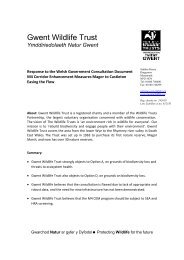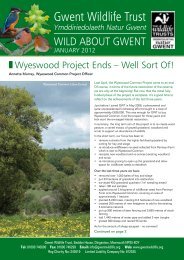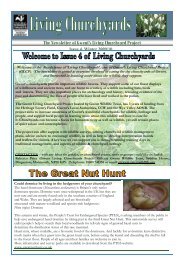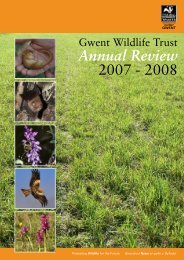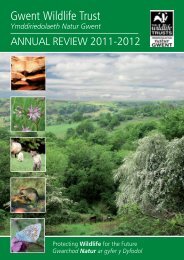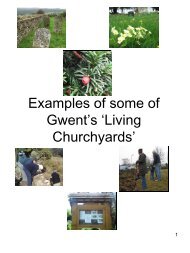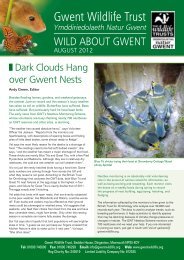Wild About Gwent April 2012.pdf - Gwent Wildlife Trust
Wild About Gwent April 2012.pdf - Gwent Wildlife Trust
Wild About Gwent April 2012.pdf - Gwent Wildlife Trust
You also want an ePaper? Increase the reach of your titles
YUMPU automatically turns print PDFs into web optimized ePapers that Google loves.
<strong>Gwent</strong> <strong>Wild</strong>life <strong>Trust</strong><br />
Ymddiriedolaeth Natur <strong>Gwent</strong><br />
<strong>Wild</strong> <strong>About</strong> <strong>Gwent</strong><br />
APRIL 2012<br />
An Interview with Trevor Evans MBE<br />
Interview by Dr Stephanie Tyler<br />
In the New Year, one of GWT’s vice-presidents, Trevor<br />
Evans, was deservedly honoured with an MBE for services<br />
to conservation. Trevor is well known in the county for<br />
the enormous amount of work he has done to further our<br />
knowledge of plants and, in particular, for his acclaimed<br />
641-page ‘The Flora of Monmouthshire’, published in 2007<br />
when he was in his early 80s.<br />
<strong>Wild</strong> daffodils at Margaret’s Wood (Rebecca Price)<br />
Long-standing GWT member, volunteer, ex-<strong>Trust</strong>ee, and expert<br />
botantist, Dr Stephanie Tyler, has had the privilege of knowing<br />
Trevor for over thirty years. She has spent many happy hours out<br />
surveying with him, listening to his tales and enjoying his wicked<br />
sense of humour.<br />
In mid-February, she caught up with Trevor at his home in<br />
Chepstow and asked him a few questions<br />
Stephanie: Where did you spend your childhood?<br />
Trevor: I was born in Portskewett and went to the infants’<br />
school at Caldicot. Then my father, who received a Distinguished<br />
Conduct Medal for bravery in the First World War, got a job at<br />
the secondary school in Chepstow and we moved to the town<br />
where I have lived ever since. My schooling was disrupted by<br />
contracting osteomyelitis when I was ten. That meant six months<br />
in hospital and two years recuperating away from school.<br />
S: What triggered your interest in plants?<br />
T: In my teens, I was passionate about cricket and often went to<br />
the Cheltenham Festival to watch matches. I frequently looked<br />
around the stands for discarded cigarette cards – many people<br />
smoked then and would throw the packets away. It was a set of<br />
wildflower cards that was the stimulus for my interest.<br />
I had hoped to go to university and had been good at maths and<br />
biology, but many teachers were called up to serve in the Second<br />
World War, among them my maths teacher. Replacements were<br />
difficult to come by and my marks suffered from all the changes,<br />
so I went to Teacher Training College at Caerleon with biology<br />
as my main subject.<br />
Afterwards, I opted to stay in Monmouthshire and got a job at the<br />
Boys’ School in Chepstow with the provision that for two years I<br />
would do supply teaching. I taught at Sudbrook, Portskewett, and at<br />
Earlswood and Itton, as Acting Head. Then I returned to Chepstow<br />
Secondary School where I remained until my retirement.<br />
Throughout my teaching career, I gradually developed my<br />
knowledge of plants – spending hours out in the field and puzzling<br />
over identifications using keys in such books as Bentham &<br />
Hooker and Clapham, Tutin, & Warburg. I only knew the English<br />
names of plants until about 1969 when the first British Plant<br />
Atlas came out. Franklyn Perring, the author of the first atlas, and<br />
Arthur Wade of the National Museum were instrumental in my<br />
becoming Botanical Recorder for Monmouthshire vice-county 35<br />
in 1972, a post I have held for forty years.<br />
S: When did you decide to write the revised and updated Flora<br />
of Monmouthshire?<br />
Continued on page 2<br />
<strong>Gwent</strong> <strong>Wild</strong>life <strong>Trust</strong>, Seddon House, Dingestow, Monmouth NP25 4DY<br />
Tel: 01600 740600 Fax: 01600 740299 Email: info@gwentwildlife.org Web: www.gwentwildlife.org<br />
Reg Charity No: 242619 Limited Liability Company No: 812535
NEWS IN BRIEF<br />
Trevor Evans MBE<br />
Warbler Arrives<br />
Just in Time for<br />
Six Nations<br />
The common yellowthroat, with its deep<br />
yellow chest and a black mask about<br />
its head is a familiar sight to many<br />
birdwatchers … in Florida.<br />
So just hours after someone walking<br />
their dog on a February morning<br />
spotted one in a Rhiwderin hedgerow<br />
and posted images online, hundreds<br />
of birdwatchers from all over the UK<br />
flocked to the scene with their cameras<br />
and binoculars.<br />
Continued from page 1<br />
T: I had intended to for a long time but<br />
could not embark on the project until I<br />
retired in 1984. Then I held meetings, wrote<br />
letters and encouraged recording in every<br />
tetrad (2km by 2km square) in the vice<br />
county. We had an annual meeting of local<br />
botanists, and I led many field meetings<br />
and sent out identification tips for difficult<br />
plants. I entered all the data I received from<br />
volunteers onto master cards – this was<br />
before computers.<br />
There was a delay when my wife, Thelma,<br />
sadly died of a brain tumour in 1999 after a<br />
long illness, and it took me many months to<br />
feel motivated again. Eventually, the atlas<br />
was published in 2007.<br />
S: When did you join the <strong>Gwent</strong> <strong>Wild</strong>life<br />
<strong>Trust</strong>?<br />
T: It must have been in the late 1960s. I<br />
was Chairman of GWT’s Scientific Sub-<br />
Committee for many years with [Secretary]<br />
Beatrix Broadfoot, Patrick Humphreys, cofounder<br />
of the <strong>Trust</strong>, and Barbara Thorne<br />
who initiated the purchase of Magor Marsh.<br />
S: What changes have you seen in<br />
Monmouthshire in your lifetime?<br />
T: The loss of flower-rich fields and their<br />
replacement with large monocultures has<br />
had a major impact. Peoples’ obsession<br />
with tidiness in the town and countryside<br />
has destroyed much of interest. Chepstow<br />
Cemetery used to have hundreds of<br />
Autumn Ladies Tresses but now these are<br />
mown off to make the grass look tidy and<br />
flower beds have extended into the rich<br />
turf.<br />
Many of the broad-leaved woodlands that<br />
I knew in my youth, such as The Minnetts<br />
(now Slade Woods) and Hardwick Wood<br />
where I recorded three hundred species<br />
of plant including many Greater Butterfly<br />
Orchids, were felled and conifers planted<br />
instead. This afforestation destroyed many<br />
woods and their flora.<br />
I used to see flooding on the <strong>Gwent</strong><br />
Levels and high water levels in the reens<br />
[the drainage ditches that criss-cross<br />
the wetlands]. Now the sea wall and<br />
pump drainage has destroyed former rich<br />
habitats.<br />
S: Finally, what do you feel are the main<br />
issues facing conservation in the UK and<br />
globally?<br />
T: The growth of the human population<br />
has to be curbed. We live in a world with<br />
finite resources and must live more simply.<br />
The world will suffer shortages of water,<br />
food, housing and work. This is already<br />
happening.<br />
An abridged version of Trevor’s interview<br />
– for the full transcript, please visit our<br />
website – www.gwentwildlife.org.<br />
New Airfield Opens<br />
Lapwings in flight (Scott Grant Crichton)<br />
Common yellowthroat<br />
(Wolfgang Wander)<br />
Scott Grant Crichton, of Llanvihangel<br />
Crucorney, has been receiving some unusual<br />
company this year.<br />
Enormous flocks of lapwings have made a<br />
field near his home their personal Heathrow.<br />
Scott estimates the flock to be possibly<br />
three hundred birds when normally he<br />
might see thirty or forty at a time.<br />
GWENT WILDLIFE TRUST x WILD ABOUT GWENT
NEWS IN BRIEF<br />
Wasp spider (Steve Davis)<br />
Iolo & Alice at the Blaenau <strong>Gwent</strong> Environmental Awards 2011 (Veronika Brannovic)<br />
Young Volunteer<br />
Embraces Opportunities<br />
Alice Hadley started volunteering at Ebbw<br />
Vale’s Environmental Resource Centre (ERC)<br />
when she was seventeen, knowing she’d like<br />
somehow to weave her way into a career in<br />
conservation. “When I first started going into<br />
the field of conservation, it was just an idea”,<br />
she says, “I didn’t know a lot about wildlife and<br />
the environment”.<br />
But she knew it was a field she wanted to<br />
explore. So with the support of the ERC<br />
staff, Alice started to soak up practical<br />
experience, learning how to display and<br />
analyse data. She put her records into<br />
spreadsheets and sent them to the local<br />
biodiversity records centre. She also<br />
learned how to get others engaged, leading<br />
her own walks around the ERC grounds and<br />
introducing people to the diverse species<br />
of plants around the ERC. Alice prepared<br />
activities for school workshops and taught<br />
people how to make their own bird boxes.<br />
The staff allowed her to nurture her skills<br />
independently by giving Alice projects such<br />
as surveying the ERC habitats and drawing<br />
a plan for an upcoming pond monitoring<br />
project. “Because they gave me the<br />
responsibility for carrying out tasks of my<br />
own”, Alice says, “and involving me in their<br />
events programme, I am more confident in<br />
my abilities and feel capable of coping with<br />
a range of different situations”.<br />
Alice picked up additional skills such as<br />
willow weaving, felt making, spinning wool,<br />
sowing, constructing bird feeders, and<br />
nest boxes. She also learned what makes<br />
the local ecology tick by getting up close<br />
with dozens of different species, such as<br />
amphibians and reptiles, bees, hedgehogs,<br />
and bats. Alice also volunteers at the<br />
Silent Valley Nature Reserve, carrying out<br />
wildflower surveys and a nest box round.<br />
When the ERC was nominated for an<br />
award at the end of 2011, Alice was<br />
asked to be filmed and speak about<br />
her participation in the ERC. This led<br />
to her attending the Blaenau <strong>Gwent</strong><br />
Environmental Awards 2011 where she<br />
met Welsh naturalist and TV presenter,<br />
Iolo Williams.<br />
Alice is just finishing up her A Levels.<br />
She says her experience volunteering<br />
played an enormous part securing a<br />
place at university where she plans to<br />
study conservation. “I would recommend<br />
volunteering with the ERC, Silent Valley or<br />
any of the GWT’s centres and reserves”,<br />
she says. “It gives you a hobby, something<br />
to be interested in and care about. It<br />
allows you to develop knowledge and<br />
understanding about nature, make some<br />
lifelong friends and most importantly have<br />
a lot of fun!”<br />
Lottery is a<br />
Big Boost for<br />
<strong>Wild</strong>life <strong>Trust</strong>s<br />
People’s Postcode Lottery (PPL)<br />
was launched in England in 2005.<br />
Their lottery brand and concept was<br />
already well-known in Sweden and The<br />
Netherlands where 40% of households<br />
play and have raised to date £16.3<br />
million for its charity partners alone,<br />
with many more millions being given to<br />
other small local projects. <strong>Wild</strong>life <strong>Trust</strong><br />
Wales (WTW) was lucky enough to be<br />
chosen as an official charity partner<br />
after the lottery branched into Wales in<br />
2010.<br />
Recently, <strong>Gwent</strong> <strong>Wild</strong>life <strong>Trust</strong><br />
Fundraising Manager, Alison McGachy,<br />
represented WTW in Edinburgh where<br />
she received a cheque for £80,470 (of<br />
which £11,000 is given to GWT) for our<br />
first charity draw.<br />
If you want more information on<br />
the work of PPL, please go to their<br />
website at www.postcodelottery.<br />
com.<br />
<strong>April</strong> 2012
NEWS IN BRIEF<br />
Celebrate our Coast by Walking<br />
the Welsh Coastal Path<br />
Otter (Richard Bakere)<br />
Prisk Wood (Jane Corey)<br />
Orb Electrical Steels<br />
Turns Industrial<br />
Setting into Fertile<br />
Ground<br />
Orb Electrical Steels, based close to<br />
Newport’s iconic Transporter Bridge<br />
and Platinum corporate member, is<br />
working with GWT to make their site<br />
more wildlife-friendly. What they’ve<br />
achieved shows how organisations can<br />
make significant changes to a site’s<br />
environment with just a little TLC.<br />
Orb Electrical Steels has:<br />
• planted a native woodland –<br />
introducing a variety of fast growing<br />
shrubs and small trees to provide an<br />
attractive mix of blossom, berries,<br />
fruit, and nuts throughout the growing<br />
season, to benefit a variety of wildlife.<br />
• created an ornamental tree avenue<br />
– demonstrating that enhancing<br />
biodivesity need not be incompatible<br />
with improving the appearance of the<br />
site. Trees have been chosen for their<br />
attractiveness as well as benefits to<br />
wildlife.<br />
• planted an orchard – preserving some<br />
of the traditional local varities of fruit<br />
tree as well as providing a harvest crop<br />
of fruit for employees. Orchards can<br />
make a wonderful habitat for wildlife<br />
and are a particularly important early<br />
nectar source for insects.<br />
A mixture of employees, local school<br />
children, and retired workers have all<br />
worked hard in turning the Orb Electrical<br />
Steels site into a rich natural setting.<br />
Richard Bakere – Reserves Officer<br />
This May, GWT is celebrating the opening<br />
of the new all Wales coastal footpath.<br />
This great achievement is an excellent<br />
opportunity to get out and enjoy the rich<br />
coastal wildlife of <strong>Gwent</strong>. From the rich<br />
mudflats, noisy with feeding waders to<br />
the lush flower-rich grasslands along our<br />
coastal margins, this is truly one of <strong>Gwent</strong>’s<br />
best kept secrets. This wildlife corridor<br />
passes through many great areas for<br />
wildlife including two GWT nature reserves:<br />
the Solutia Meadows SSSI reserve and<br />
Peterstone Wentlooge Marshes SSSI<br />
(a sensitive refuge area agreed with the<br />
Peterstone <strong>Wild</strong>fowlers).<br />
So on Sunday 6th May, to mark the<br />
occasion, we will be encouraging people to<br />
walk the new path. Newport City Council<br />
will be leading a city to sea walk, leaving<br />
from the Newport Transporter Bridge at<br />
11am and passing through the Solutia<br />
Meadows SSSI reserve on the way to finish<br />
at the Newport Wetlands reserve. For more<br />
information please look at www.newport.<br />
gov.uk/countryside.<br />
There will be guided walks around Solutia<br />
Meadows delivered with the help of<br />
the <strong>Wild</strong>life in Newport Group (WING)<br />
throughout the afternoon between noon<br />
and 4pm, each taking about an hour. The<br />
species-rich hay meadows of this site are<br />
alive with the colours of southern marsh<br />
orchids and hay rattle at this time of year.<br />
Alternatively, please walk any section of<br />
the path you wish and make a note of the<br />
wildlife you see on your way. If you share<br />
these records with the South East Wales<br />
Biological Records Centre (www.sewbrec.<br />
org.uk), we can form a lasting record of the<br />
coastal wildlife of our county.<br />
Guests Get Warm Welcome at<br />
Magor Marsh<br />
Our Magor Marsh nature reserve was<br />
recently visited by Welsh Environment<br />
Minister and Assembly Minister for<br />
Newport East, John Griffiths. He met<br />
Helen and Kathy, our Community<br />
Education Officers, as well as Denis<br />
Jackson, People & <strong>Wild</strong>life Manager, and<br />
GWT Chairman, Dave Richards.<br />
The minister said he appreciated how well<br />
maintained the reserve is, through the<br />
work of the Reserves Department and<br />
the volunteer ‘<strong>Gwent</strong> Levellers’ group. He<br />
was also very interested in the educational<br />
aspect of the work at Magor after seeing<br />
the local school children engaging so<br />
closely with nature at the Marsh. The<br />
issues of a potential M4 Relief road are<br />
important to him so he spent considerable<br />
time observing and asking questions.<br />
John Griffiths, AM, visits Magor Marsh<br />
(Kathy Barclay)<br />
GWENT WILDLIFE TRUST x WILD ABOUT GWENT
Lauri tackles one of her team (Annette Murray)<br />
NEWS IN BRIEF<br />
Lauri & Gabi: Off to Pastures New<br />
GWT’s Lauri Maclean started in 2002<br />
in the administration department<br />
before moving into the Conservation<br />
Department and eventually becoming<br />
Reserves Manager.<br />
Over those years Lauri shaped<br />
so many projects. Lauri was a<br />
key driving force in developing<br />
Wyeswood Common into a<br />
wood-pasture landscape and<br />
helping to obtain the £636,000<br />
required for the project. She<br />
built the reserves team up from<br />
a single officer to a team of<br />
four and updated management<br />
plans for all GWT reserves.<br />
She oversaw the purchase<br />
and development of the Pentwyn flock of<br />
Hebridean and Hill Radnor Sheep, built<br />
excellent relationships with Countryside<br />
Council for Wales, RSPB, Environment<br />
Agency Wales, Forestry Commission Wales,<br />
and all the local authorities in <strong>Gwent</strong>. She<br />
negotiated leases at Great Traston Meadows<br />
(now Solutia Meadows SSSI reserve), and<br />
organised management agreements at<br />
Cuhere Wood, Lower Minnets Field, and<br />
Beacon Hill with Forestry Commission Wales.<br />
Gabi (John Stalley)<br />
GWT MATCH FUND APPEAL – A THANK YOU<br />
Landfill Communities Fund – Success for Two out of Three so Far<br />
We want to thank everyone who is<br />
contributing to GWT’s Match Fund Appeal<br />
for their support. This generosity has enabled<br />
GWT to acquire nearly £80,000 from the<br />
Landfill Communities Fund.<br />
Thanks to donations of nearly £10,000, GWT<br />
was able to qualify for two grants using<br />
the fund for much needed habitat work at<br />
some of most important reserves. Due to<br />
press embargoes, we’re unable to report the<br />
details here but as soon as we are able, we’ll<br />
have something up on our website.<br />
Lauri was always approachable and found<br />
time to discuss any issues no matter how<br />
much pressure she was under. Lauri was a<br />
very modest person who never celebrated her<br />
achievements. So we will. Thank you Lauri.<br />
Lauri’s departure to go and work<br />
for the <strong>Wild</strong>fowl and Wetlands<br />
<strong>Trust</strong> at Slimbridge has left a large<br />
hole in the Reserves department.<br />
But we all wish you a very<br />
successful future.<br />
For those of you who haven’t<br />
yet heard, Gabi Horup, our<br />
Conservation Officer, will also be<br />
leaving us for pastures new. Gabi<br />
has accepted an offer to work as<br />
Ecologist with Nicholas Pearson<br />
Associates, based in Bath, a move<br />
which will better allow the pursuit of some<br />
personal life ambitions over the coming years.<br />
Gabi has contributed enormously to the work<br />
of GWT throughout her three years with us,<br />
demonstrating huge commitment, talent and<br />
knowledge. She has been invaluable to GWT<br />
and the wider environment team will certainly<br />
miss her greatly.<br />
A big thank you Gabi and good luck with<br />
your new position!<br />
And we’re still awaiting word of a third<br />
grant. So keep your eyes peeled for further<br />
news.<br />
Once again we want to thank everyone<br />
for their support and donations. But more<br />
needs to be done to protect our wildlife<br />
and keep our countryside beautiful for<br />
generations. We still need your help. To<br />
make a donation to the GWT Match Fund<br />
Appeal, call us on 01600 740600 or Text<br />
WILD22 £10 to 70070 or go to www.<br />
gwentwildlife.org to donate online.<br />
Cowslips (Zsuzsanna Bird)<br />
Other<br />
Corporate<br />
News<br />
We are purchasing our much needed<br />
hedge trimmers and tractor servicing<br />
from Frank Sutton Ltd. This family<br />
run business is a trusted local dealer,<br />
based in Raglan, and is also a Bronze<br />
Corporate member of <strong>Gwent</strong> <strong>Wild</strong>life<br />
<strong>Trust</strong>.<br />
Having taken advice from <strong>Gwent</strong> Ecology,<br />
GWT’s consultancy business, Ancre Hill<br />
Vineyard, our latest Bronze corporate<br />
member, has made significant changes<br />
to its proposed winery development to<br />
preserve a species-rich hedgerow which<br />
provided habitat suitable for dormice and<br />
other declining species.<br />
Keeping in<br />
Touch<br />
We are always very keen to keep in<br />
touch with our membership, via our<br />
literature, facebook, twitter, emails and by<br />
telephone. In particular, if you would like<br />
to hear our latest news and events, please<br />
do get in touch with Rachael on rdaniels@<br />
gwentwildlife.org and let us know your<br />
email address. If you haven’t received an<br />
email from us this year, then you’re not on<br />
our list and are missing out on the latest<br />
information. We may also get in touch with<br />
you by telephone – if you would prefer<br />
NOT to receive phone calls from us, drop<br />
Rachael an email to let her know.<br />
<strong>April</strong> 2012
GWT LOCAL GROUPS<br />
Pheasant (Neil Aldridge)<br />
LOCAL GROUP CONTACTS<br />
Abergavenny Local Group<br />
Keith White 01873 852036<br />
keith.white@tesco.net<br />
Blaenau <strong>Gwent</strong> Local Group<br />
Rodney Morris 01495 308056<br />
remorris66@mailshack.com<br />
Chepstow Local Group<br />
Hilary Lee 01291 689326<br />
hilary-lee@tiscali.co.uk<br />
GWT Office 01600 740600<br />
info@gwentwildlife.org<br />
Monmouth Local Group<br />
Alison Willott 01600 740286<br />
alisonwillott@hotmail.com<br />
Torfaen Local Group<br />
Vicky Hannaford 01495 759139<br />
v.hannaford@hotmail.co.uk<br />
Usk Local Group<br />
David Gale 01291 673141<br />
david@gale4241.fsworld.co.uk<br />
<strong>Wild</strong>life in Newport Group<br />
Roger James 01633 263374<br />
smallranunculus@btinternet.com<br />
For more information on our work tasks<br />
and any volunteering, see the GWT<br />
Events Guide 2012 or go to<br />
www.gwentwildlife.org.<br />
Harvest mouse (Amy Lewis)<br />
<strong>April</strong> to July 2012<br />
To book on any GWT event, contact<br />
GWT on 01600 740600, the ERC on<br />
01495 307525, or email us on info@<br />
gwentwildlife.org. Full details of all these<br />
courses can be found in the GWT Events<br />
Guide 2012 or on www.gwentwildlife.org.<br />
APRIL 2012<br />
Trip to Silent Valley<br />
<strong>April</strong> (date TBA)<br />
Contact: GWT Abergavenny Local Group,<br />
01873 852036<br />
Please contact Keith White on the above<br />
number to indicate your interest<br />
<strong>Wild</strong>life in <strong>Gwent</strong><br />
Speaker: Colin Titcombe<br />
Tuesday 10th <strong>April</strong>, 7.30pm<br />
The Ballroom, Glen-yr-Afon House Hotel,<br />
Usk<br />
Contact: GWT Usk Local Group,<br />
01291 673141<br />
Cost: £2, under 16s FREE (accompanied by<br />
an adult only)<br />
Birds of Silent Valley<br />
Leader: Tom Eyles<br />
Wednesday 11th <strong>April</strong>, 10.30am – 12.30am<br />
Silent Valley Nature Reserve, near Ebbw Vale<br />
Contact: ERC, 01495 307525<br />
Cost: FREE<br />
Spring Wellbeing<br />
Thursday 12th <strong>April</strong>, 11am – 4pm<br />
ERC, Ebbw Vale<br />
Contact: ERC, 01495 307525<br />
Cost: FREE<br />
Refreshments available<br />
Spring Fun Day at the ERC<br />
Wednesday 18th <strong>April</strong>, 1pm – 4pm<br />
ERC, Ebbw Vale<br />
Contact: ERC, 01495 307525<br />
Cost: FREE<br />
Refreshments available<br />
A Beginner’s Guide to Woodland<br />
Management<br />
Tutor: Tim Green<br />
Friday 27th <strong>April</strong>, 10.30am – 3pm<br />
Springdale Farm, near Usk<br />
Contact: GWT, 01600 740600<br />
Cost: £14 members, £18 non members<br />
BOOKING ESSENTIAL<br />
Cwmtillery Lakes Bat Walk<br />
In partnership with the Valleys Bat<br />
Group<br />
Leader: Richard Poole<br />
Friday 27th <strong>April</strong>, 7.45pm – 10pm<br />
Cwmtillery Lakes, near Abertillery<br />
Contact: GWT, 01600 740600<br />
Cost: FREE<br />
BOOKING ESSENTIAL<br />
The History of Millstone<br />
Extraction<br />
Tutor: Bob Trett & Roger James<br />
Saturday 28th <strong>April</strong>, 11am – 2.30pm<br />
Pentwyn Farm and Prisk Wood, near<br />
Monmouth<br />
Contact: GWT, 01600 740600<br />
Cost: £6 members, £9 non members<br />
BOOKING ESSENTIAL<br />
MAY 2012<br />
Spider Identification<br />
Tutor: Mike Kilner<br />
Saturday 5th May, 11am – 4pm<br />
Magor Marsh, near Newport<br />
Contact: GWT, 01600 740600<br />
Cost: £12 members, £16 non members<br />
BOOKING ESSENTIAL<br />
Permaculture Basics<br />
Tutor: Veronika Brannovic<br />
Wednesday 9th May, 10.30am – 3pm<br />
ERC, Ebbw Vale<br />
Contact: ERC, 01495 307525<br />
Cost: £3 members, £6 non members<br />
BOOKING ESSENTIAL<br />
Refreshments provided<br />
Grow, Make and Show<br />
Saturday 12th May, 2pm – 4.30pm<br />
ERC, Ebbw Vale<br />
Contact: ERC, 01495 307525<br />
Cost: FREE<br />
Refreshments available<br />
Grand Plant Sale and Bazaar<br />
Hosts: GWT Chepstow Local Group<br />
Saturday 19th May, 9.30am – 12.30pm<br />
Palmer Centre, Cormeilles Square,<br />
Chepstow<br />
Contact: GWT Chepstow Local Group,<br />
01291 689326<br />
Cost: FREE<br />
Offers of help and plants to Hilary Lee on<br />
the number above, please<br />
Open Gardens at Coed Cefn<br />
In aid of GWT<br />
Sunday 20th May, 2pm – 6pm<br />
Dingestow, near Monmouth (this event will<br />
be sign posted from the A40)<br />
Contact: GWT Monmouth Local Group,<br />
01600 740286<br />
Refreshments available<br />
Cost: £3.50<br />
Grassland Restoration –<br />
Countryside Management Association<br />
Training Day<br />
Host: Tim Green<br />
Friday 25th May, 10am – 4pm<br />
Pentwyn Farm and Wyeswood Common,<br />
near Monmouth<br />
Contact: GWT, 01600 740600<br />
Cost: FREE to CMA members, £30 to non<br />
CMA members<br />
BOOKING ESSENTIAL<br />
GWENT WILDLIFE TRUST x WILD ABOUT GWENT
Summer Fun Day at Magor Marsh<br />
Hosts: Kathy Barclay & Helen John<br />
Saturday 26th May, 1pm – 4pm<br />
Magor Marsh, near Newport<br />
Contact: GWT, 01600 740600<br />
Cost: £1 children, adults FREE<br />
JUNE 2012<br />
Trip to Sennybridge<br />
June (date TBA)<br />
Contact: GWT Abergavenny Local Group,<br />
01873 852036<br />
Please contact Keith White on the above<br />
number to indicate your interest<br />
<strong>Wild</strong> Explorers<br />
Leader: Tom Eyles<br />
Wednesday 6th June, 10.30am – 3pm<br />
Silent Valley Nature Reserve, near Ebbw<br />
Vale<br />
Contact: ERC, 01495 307525<br />
Cost: FREE<br />
BOOKING ESSENTIAL<br />
Botany Basics<br />
Tutor: Dave Green<br />
Thursday 7th June, 10.30am – 3pm<br />
ERC, Ebbw Vale<br />
Contact: ERC, 01495 307525<br />
Cost: £3 members, £6 non members<br />
BOOKING ESSENTIAL<br />
Refreshments available<br />
Bumblebees for Beginners<br />
Tutor: Marc Carlton<br />
Saturday 9th June, 10.30am – 3pm<br />
Pentwyn Farm, near Monmouth<br />
Contact: GWT, 01600 740600<br />
Cost: £12 members, £16 non members<br />
BOOKING ESSENTIAL<br />
National Gardens Scheme Open Day<br />
Host: Annette Murray<br />
Sunday 10th June, 10am – 4pm<br />
Pentwyn Farm, near Monmouth<br />
Contact: GWT, 01600 740600<br />
Cost: £3, children FREE<br />
Tea and coffee available<br />
Meadow Plant Identification for<br />
Beginners<br />
Tutor: Rebecca Price<br />
Thursday 14th June, 10am – 12.30pm<br />
Pentwyn Farm, near Monmouth<br />
Contact: GWT, 01600 740600<br />
Cost: £6 members, £9 non members<br />
BOOKING ESSENTIAL<br />
Plant Stall at Usk Open Gardens<br />
Weekend<br />
Hosts: GWT Chepstow Local Group<br />
Saturday & Sunday 23rd & 24th June,<br />
10am – 5pm<br />
Gardeners’ Market on the field next to the<br />
Memorial Hall, Usk<br />
Contact: GWT Chepstow Local Group,<br />
01291 689326<br />
Charcoal Making<br />
Tutor: Jan Kinchington<br />
Wednesday 27th June, 10am – 4pm<br />
Croes Robert, near Monmouth<br />
Contact: GWT, 01600 740600<br />
Cost: £8 members, £12 non members<br />
BOOKING ESSENTIAL<br />
Bat and Moth Walk<br />
Leader: Tom Eyles<br />
Wednesday 27th June, 9pm onwards<br />
Silent Valley Nature Reserve, near Ebbw Vale<br />
Contact: ERC, 01495 307525<br />
Cost: £3 members, £6 non members<br />
BOOKING ESSENTIAL<br />
JULY 2012<br />
The Changing Scenery of Magor<br />
Marsh – Summer<br />
Tutor: Paul Cawley<br />
Sunday 1st July, 2pm – 4.30pm<br />
Magor Marsh, near Newport<br />
Contact: GWT, 01600 740600<br />
Cost: £6 members, £9 non members<br />
BOOKING ESSENTIAL<br />
Goatsuckers Return<br />
Leader: Tom Eyles<br />
Tuesday 3rd July, 9.15pm onwards<br />
Beacon Hill Reserve, near Trellech<br />
Contact: ERC, 01495 307525<br />
Cost: £3 members, £6 non members<br />
BOOKING ESSENTIAL<br />
Cleddon Bog<br />
Leader: Dave Green<br />
Monday 9th July, 10am – 2pm<br />
Cleddon Bog, near Trellech<br />
Contact: GWT, 01600 740600<br />
Cost: £6 members, £9 non members<br />
BOOKING ESSENTIAL<br />
Trapping and Identifying Moths<br />
Tutor: Val Jackson<br />
Saturday 14th July, 9.30am – 12.30pm<br />
Tidenham Chase, near Chepstow<br />
Contact: GWT, 01600 740600<br />
Cost: £4 members, £7 non members<br />
BOOKING ESSENTIAL<br />
Magor Marsh Open Day<br />
Hosts: Kathy Barclay & Helen John<br />
Saturday 21st July, 1pm – 5pm<br />
Magor Marsh, near Newport<br />
Contact: GWT, 01600 740600<br />
Cost: £2 adults (£1 for members or those<br />
walking to the event), £1 children, £5<br />
families<br />
Minibeast Adventures<br />
Leader: Tom Eyles<br />
Wednesday 25th July, 10.30am –<br />
12.30pm<br />
Silent Valley Nature Reserve, near Ebbw Vale<br />
Contact: ERC, 01495 307525<br />
Cost: FREE<br />
BOOKING ESSENTIAL<br />
Snowdrops (Amy Lewis)<br />
Uncommon<br />
Fungi Found<br />
NEWS IN BRIEF<br />
Meet Terana caerulea – also known as the<br />
Colbalt Crust Fungus. This very distinctive<br />
(and dare we say, beautiful) fungus was<br />
found by GWT member and stalwart<br />
volunteer, Chris Field, in late November on<br />
a dead stick lying in leaf litter on the ground<br />
in Croes Robert Wood.<br />
The species does not seem to have been<br />
recorded here before and there are only<br />
six other records across the rest of old<br />
Monmouthshire. <strong>Gwent</strong> Fungus Group have<br />
added the sighting to their database which<br />
gets copied to the FRDBI (Fungus Record<br />
Database of Britain and Ireland) managed<br />
by the British Mycological Society.<br />
Cobalt Crust fungus covering the dead<br />
wood (Chris Field)<br />
<strong>April</strong> 2012
NEWS IN BRIEF<br />
Danger of chinese lanterns<br />
(Laura Crotch-Harvey)<br />
Dangers Expose<br />
the Dark Side of<br />
Chinese Lanterns<br />
There is a scene in the Disney animated<br />
film, Tangled, when tens of thousands of<br />
Chinese lanterns illuminate the night sky<br />
all at once. Although it seems tranquil and<br />
lovely, it’s just as well it’s a cartoon.<br />
Chinese lanterns are causing such a<br />
destructive environmental impact on<br />
UK coasts and countryside that the<br />
National Farmers’ Union and the Marine<br />
Conservation Society are calling for them to<br />
be banned outright. The paper lanterns are<br />
commonly made with thin wires that cause<br />
widespread littering, and often harm wildlife<br />
and farm animals.<br />
According to one NFU policy manager:<br />
“Across the UK, there have been numerous<br />
reports of harm to livestock, and in some<br />
instances death, when lanterns have landed<br />
in farmers’ fields, and cattle have ingested<br />
the metal wires. There is a further risk to<br />
cattle when grass is cut for winter feed: the<br />
wire is chopped up and subsequently found<br />
in hay or silage”.<br />
Falling lanterns still alight have burned fields<br />
and buildings. Spain is the most recent<br />
nation to ban them. The lanterns have<br />
previously been banned in Vietnam after<br />
causing numerous forest fires, and in three<br />
German states, after a lantern was blamed<br />
for the death of a boy in a house fire.<br />
A petition has been set up calling for a<br />
ban on the sale of Chinese lanterns in the<br />
UK. For more information, go to http://<br />
epetitions.direct.gov.uk/petitions/13051.<br />
As stories about the effects of global<br />
warming pervade the news, GWT’s<br />
Conservation Officer, Sorrel Jones takes<br />
a glance at how last year’s unbalanced<br />
weather took its toll on <strong>Gwent</strong>’s countryside<br />
and what it means for 2012.<br />
2011 - A very confusing year for<br />
wildlife<br />
Looking back at 2011, did you feel that<br />
spring just merged into a long autumn, and<br />
summer didn’t really happen at all? Rather<br />
than our usual distinct seasons, our weather<br />
got rather muddled, throwing our wildlife into<br />
a state of confusion in the process.<br />
Following that severe winter of 2010-2011,<br />
our birds, insects, and mammals were<br />
probably pretty grateful for the warm (if<br />
rather dry) spring. Most animal and plants<br />
are triggered into their spring activities<br />
of growing, feeding, and breeding by a<br />
combination of day length, water availability,<br />
and temperature. The thresholds vary<br />
between species and are often influenced<br />
by ecological factors – woodland flowers<br />
tend to bloom early, before they are shaded<br />
out by the trees above them. The delicate<br />
relationship between plants and pollinators<br />
can be affected if the weather causes them<br />
to lose their synchronicity – if our nectarloving<br />
insects emerge too early, there may<br />
be very little for them to feed on.<br />
Sadly, the good fortune was not to last, as<br />
the summer was a cold one. Birds like blue<br />
tits and dippers that had confidently started<br />
second broods suffered and many failed<br />
entirely. The lack of sunshine meant that<br />
we didn’t see as many bees and butterflies<br />
as usual either. The dry spring and summer<br />
may also have affected habitats – as<br />
Hibernating dormouse (Danny Green)<br />
The State of Our <strong>Wild</strong>life<br />
Water vole (Tom Marshall)<br />
some of the wetlands around the county<br />
are suffering from low water levels. This<br />
impacts on the plants and invertebrates<br />
that are adapted to wet habitats such as<br />
marshes and bogs.<br />
The weather became kind again with the<br />
second warmest autumn in a hundred<br />
years. A bountiful autumn is beneficial for<br />
most wildlife, especially those staying with<br />
us over the winter, as they build up fat<br />
supplies to see them through the leaner<br />
months. We even saw butterflies flying into<br />
November and December. Indeed, a few of<br />
our birders were disappointed that we saw<br />
less of our winter visitors, such as redwing<br />
and waxwing, because the weather wasn’t<br />
cold enough in Europe to drive them here.<br />
GWENT WILDLIFE TRUST x WILD ABOUT GWENT
NEWS IN BRIEF<br />
Waxwing (Margaret Holland)<br />
– A Year in Review<br />
As the long autumn wore on, we began to<br />
worry about our hibernating wildlife. Our bats,<br />
dormice, hedgehogs, reptiles, and amphibians<br />
need cold weather to start hibernating, but<br />
also for it to stay cold so that they don’t wake<br />
up too soon. A very mild winter can result in<br />
disturbed hibernation, which means those<br />
animals use up their valuable reserves, looking<br />
for food that isn’t yet there. We will have<br />
to wait and see how the recent frosts have<br />
impacted on these early risers.<br />
The good news<br />
Despite the jumbled weather, 2011 wasn’t<br />
completely without successes. GWT’s<br />
conservation efforts – surveying, management,<br />
and advice – are bringing about results.<br />
Dormice were recorded for the first time<br />
in Strawberry Cottage Wood and Cuhere<br />
Wood. Water voles are returning to the north<br />
of the <strong>Gwent</strong>. Meadow thistle has returned<br />
to Cleddon Bog SSSI following restoration<br />
management. And the second site for the rare<br />
Silurian moth in Wales was also found.<br />
<strong>Gwent</strong><br />
Ecology<br />
Comprehensive, professional and<br />
pragmatic ecological services for<br />
planning, development and conservation<br />
The state of things to come<br />
So what’s in store for 2012? GWT will continue<br />
to work hard to protect and encourage wildlife<br />
in <strong>Gwent</strong> during the <strong>Wild</strong>life <strong>Trust</strong>s movement’s<br />
centenary year. It’s also a big year for policy,<br />
with expected consultations on plans and<br />
policies covering everything from delivery of<br />
nature conservation and management across<br />
Wales and Marine Protected Areas, down to<br />
local development plans at the county level.<br />
Climate change predictions state that if we<br />
are not able to limit the global temperature<br />
rise to two degrees, we will experience much<br />
more extreme, less predictable weather<br />
patterns. The weather patterns we’ve seen in<br />
2011 show how even small changes from the<br />
norm can have serious impacts on our wildlife.<br />
Although conservationists can help wildlife by<br />
creating and managing high quality, connected<br />
habitats, we can’t stop climate change by<br />
ourselves. It’s up to everyone to try.<br />
Thanks to Martin Anthoney, Jan Kinchington,<br />
Steph Tyler, and Steve Williams.<br />
<strong>Gwent</strong> Ecology • Seddon House • Monmouth • NP25 4DY<br />
T 01600 740600 • F 01600 740299 • info@gwentecology.co.uk<br />
www.gwentecology.co.uk<br />
Leucistic dunnock<br />
(John Harding BTO)<br />
What Turns<br />
a Blackbird<br />
White?<br />
A recent article from The Telegraph says<br />
ornithologists are searching for clues to<br />
a mystery condition that causes birds to<br />
have unusually coloured plumage. The<br />
discolouration, called leucism, can turn<br />
house sparrows pink, red woodpeckers<br />
yellow, and crows white.<br />
Some ornithologists believe the condition<br />
may be caused by changes in diet.<br />
Populations of house sparrows living by a<br />
Scottish salmon farm became pink after<br />
feeding on prawn shells used to give<br />
salmon more colour. Scientists believe<br />
the yellow on blue tit breasts comes from<br />
the volume of caterpillars they eat. If<br />
there are fewer caterpillars, the colour<br />
fades. And unlike albinos, whose eyes are<br />
pink, leucistic birds retain normal coloured<br />
eyes.<br />
A survey by the British <strong>Trust</strong> for<br />
Ornithology will examine the reasons for<br />
the colour variations and see how they<br />
might influence behaviour. For instance,<br />
robins with white breasts seem to more<br />
shy then those with red breasts.<br />
If you see a wild bird with some form<br />
of plumage abnormality, then please<br />
report it to the BTO Abnormal Plumage<br />
Survey – www.surveymonkey.com/s/<br />
plumagesurvey. To learn more about<br />
the Abnormal Plumage Survey, visit the<br />
British <strong>Trust</strong> for Ornithology website at<br />
www.bto.org/gbw.<br />
<strong>April</strong> 2012
NEWS IN BRIEF<br />
Beacon Hill (Gabi Horup)<br />
GWT Chepstow<br />
Local Group<br />
Needs You!<br />
After another successful season of<br />
attending various events and putting on<br />
plant sales, the Chepstow Group raised<br />
£1,415 in 2011. The money raised is<br />
already going to some much needed<br />
maintenance and improvements at the<br />
Magor Marsh Reserve. A new bridge has<br />
been erected, an orchard planted, and<br />
other useful work is under way.<br />
The bad news is that their hard-working<br />
gazebo has sustained an injury and will not<br />
be able to provide them with shade and<br />
shelter for this year’s plant sales. If anyone<br />
has a three metre square pop-up gazebo<br />
which they no longer need, or even sees<br />
one at a really good price, please give<br />
Hilary Lee a ring on 01291 689326.<br />
They’re also looking for some new trainee<br />
face painters! Face painting is such a<br />
popular attraction for open days and is<br />
a marvellous way of raising funds while<br />
giving us time to chat to families. If you<br />
would like to be an artist and make<br />
children happy at the same time, please<br />
contact Hilary or the GWT office on<br />
01600 740600.<br />
GWT Usk Local<br />
Group Also Excels<br />
And not to be outdone, members of the<br />
GWT Usk Local Group have recently<br />
raised £1000. The money will be used for<br />
much needed fencing at Silent Valley and<br />
bridges at Magor Marsh.<br />
Nurturing Monmouthshire’s<br />
Natural Assets<br />
Rebecca Price – Project Officer<br />
GWT’s latest project, supporting some<br />
of our best places for wildlife (what we<br />
officially call Local <strong>Wild</strong>life Sites or LWS),<br />
has attracted much interest since it began<br />
last summer.<br />
The Monmouthshire Natural Assets<br />
Project, a collaborative effort with<br />
Monmouthshire County Council, is working<br />
to restore, maintain and add value to the<br />
county’s Local <strong>Wild</strong>life Sites. The project<br />
is able to offer wildlife and management<br />
advice to LWS owners and managers,<br />
along with grants of up to £2,000 to help<br />
with capital works projects supporting<br />
restoration and site enhancement.<br />
The first grant panel meeting awarded<br />
a total of almost £8,000 to six Local<br />
<strong>Wild</strong>life Sites, with a further £10,000<br />
provisionally awarded to a further seven<br />
sites at the last panel meeting. The grant<br />
money will contribute significantly to the<br />
conservation and enhancement of these<br />
high-value nature sites. A number of the<br />
projects have been for fencing to enable<br />
wildflower-rich grassland to be sensitively<br />
grazed. <strong>Wild</strong>flower-rich grasslands depend<br />
on careful management through hay<br />
cutting and grazing. Without proper care,<br />
wildflower diversity declines and these<br />
sites can be lost to encroaching scrub or<br />
invasive species.<br />
Hedgelaying works at Stevenstone<br />
Meadow LWS (Rebecca Price)<br />
With the help of a seasonal surveyor,<br />
we’ll also be identifying new Local <strong>Wild</strong>life<br />
Sites. To date, GWT and Monmouthshire<br />
Meadows Group survey efforts have<br />
focused on identifying species-rich<br />
grasslands, but we’ll also be looking to<br />
assess other habitat types over the next<br />
two years.<br />
If you have land which you think may be<br />
of LWS quality and would like a survey<br />
or habitat management advice, please<br />
do contact me at rprice@gwentwildlife.<br />
org or for more information, go to www.<br />
gwentwildlife.org/mon_nat_assets.htm.<br />
The project is one of a suite of<br />
projects supported under Axis 3 of the<br />
Monmouthshire Rural Development Plan<br />
funded by the Welsh Government and<br />
the European Agricultural Fund for Rural<br />
Development. We’re also grateful to the<br />
Countryside Council for Wales (CCW)<br />
who also provides funding for the project.<br />
Common blue butterfly (Amy Lewis)<br />
GWENT WILDLIFE TRUST x WILD ABOUT GWENT
Coppicing at Magor Marsh<br />
NEWS IN BRIEF<br />
Shrill Carder Bee (Gabi Horup)<br />
School orchard planting (Kerry Schartz)<br />
School Orchards<br />
Alice Rees – <strong>Gwent</strong> Orchards Project Officer<br />
We all know how wonderful orchards<br />
are. They are biodiversity hotspots and<br />
an example of a traditional agricultural<br />
practice which forms a distinct part of our<br />
heritage. It is not surprising, then, that the<br />
importance of orchards is being recognised<br />
more and more as an irreplaceable learning<br />
resource for our school children.<br />
The <strong>Gwent</strong> Orchards Project was awarded<br />
funding from the Wye Valley AONB<br />
Sustainable Development Fund this year to<br />
plant orchards with primary schools in the<br />
Monmouthshire part of the AONB (Area<br />
of Outstanding Natural Beauty). Orchards<br />
were planted at Trellech and Llandogo<br />
Primary schools this January, which meant<br />
Alice Rees, <strong>Gwent</strong> Orchards Project Officer,<br />
along with the help of Gabrielle Horup,<br />
Conservation Officer, and Nicola Stone,<br />
Assistant Conservation Officer, got their<br />
hands dirty with some very excitable groups<br />
of school children!<br />
Five fruit trees were planted at each school,<br />
three apples, a pear and a plum. Varieties were<br />
chosen for their disease resistance and fruit<br />
production. “It was extremely important to<br />
choose trees which would fruit during the school<br />
year”, said Alice, “which meant that we were<br />
not able to plant heritage varieties. However at<br />
least we know the trees require minimal care<br />
and that the children can enjoy watching the<br />
fruit grow, and eating it afterwards!”.<br />
The orchards will provide an important<br />
outdoor classroom for the children to learn<br />
from in years to come. <strong>Wild</strong>life will be<br />
attracted to the blossom and fruit, helping<br />
increase the children’s knowledge of the<br />
natural world around them. Understanding<br />
where our food comes from can also be<br />
taught. We hope enough fruit will be available<br />
eventually, to enable the teachers and<br />
children to juice it and even sell it at school<br />
events. Thank you to everyone at Trellech<br />
and Llandogo for all your enthusiasm and help<br />
with the orchards!<br />
Winter bird feeding sites<br />
GWT worked with five local authorities across <strong>Gwent</strong> to produce a network of<br />
winter bird feeding sites last year. If you have a spare corner of land where you<br />
would like to create a feeding site, then please download our new leaflet from<br />
www.gwentwildlife.org for some useful hints and tips!<br />
Shrill Carder<br />
Bee Project<br />
takes Flight<br />
The <strong>Gwent</strong> Levels are a stronghold for<br />
the shrill carder bee, a bumblebee on the<br />
verge of extinction and in need of urgent<br />
conservation.<br />
GWT has developed a two-year project<br />
which will increase awareness of this rare<br />
bee and its habitat in <strong>Gwent</strong>. We are<br />
hoping to expand its range around the<br />
levels by working with area landowners to<br />
provide wildflower-rich habitats.<br />
The project, working in coordination with<br />
the Bumblebee Conservation <strong>Trust</strong>, will<br />
enlist volunteers to monitor the bees and<br />
their habitats. If you would like to know<br />
more about the project, or become a<br />
volunteer, please contact Rebecca Price<br />
on rprice@gwentwildlife.org or call her on<br />
01600 740600.<br />
Shrill Carder Bee<br />
Project Area<br />
<strong>April</strong> 2012
WAGTales<br />
Blackcap<br />
(Steve<br />
Waterhouse)<br />
In May 2011, Solutia, one of GWT’s Gold<br />
corporate members, hosted the second<br />
<strong>Wild</strong>life Wizards Quiz, a quiz designed to<br />
test youngsters knowledge of nature and<br />
local wildlife.<br />
Twelve <strong>Gwent</strong> schools participated, including<br />
four from the Newport area. Solutia<br />
generously provided a buffet lunch for all<br />
the children, teachers, and parents as well<br />
as t-shirts and prizes. The quiz was won<br />
by Glan Usk School from Newport and the<br />
teams finished the day with a tour of the<br />
GWT Solutia Meadows SSSI reserve. Solutia<br />
have once again agreed to host our <strong>Wild</strong>life<br />
Wizards Quiz Final in 2012, so many thanks<br />
for their continued support.<br />
Wales Coastal Path<br />
Solutia have agreed to open up some of<br />
their land and allow it to be used for a<br />
public right of way linking with the Wales<br />
Coastal Path, due to be officially opened on<br />
<strong>Wild</strong>life Wizard Winners (Russ Johnson)<br />
Gold Star for our Corporate<br />
Member – Solutia<br />
6th May 2012. The payment they received<br />
from Newport City Council for doing this<br />
was generously donated to GWT.<br />
Solutia Meadows SSSI Reserve –<br />
Landfill Communities Fund Grant<br />
Boost<br />
GWT has successfully secured a grant of<br />
over £30,000 for work to be carried out at<br />
the reserve over the coming years. Two of<br />
our corporate members, Advanced Elastomer<br />
Systems and Solutia, have kindly donated<br />
thousands of pounds to help match fund this<br />
grant. Without their support, we would not be<br />
able to take this exciting project forward.<br />
Solutia Site Manager, Stephen Hampson<br />
says, “GWT has undertaken some excellent<br />
work since they took over management<br />
of the reserve in 2001 and Solutia are<br />
delighted to support work to further<br />
enhance this threatened habitat”.<br />
During the colder season, humans<br />
aren’t the only ones holidaying in sunny<br />
Spain. A blackcap, ringed from an<br />
on-going project at Magor Marsh in<br />
June 2010 was recaptured 99 days and<br />
1650km later near Malaga in Spain.<br />
During that time, even though much<br />
of it spent migrating, it managed to<br />
increase its body weight by nearly 20%!<br />
Little egret<br />
(Steve Waterhouse)<br />
The huge flocks<br />
of jackdaws<br />
and corvids,<br />
descending for<br />
their evening<br />
roost at Magor<br />
Marsh continues<br />
to provide a great<br />
spectacle soon<br />
after sunset, but they have also been joined<br />
by about a dozen egrets roosting on the<br />
trees at the north end of the pond. Both are<br />
a great sight, particularly when the colours<br />
of the sunset are fading from the sky.<br />
CBP00011260712110205<br />
Corporate Members<br />
Platinum<br />
Caldicot & Wentlooge<br />
Levels IDB<br />
Meritor Ltd<br />
Orb Electrical Steels<br />
Tata Steel<br />
Gold<br />
Advanced Elastomer Systems<br />
International Rectifier<br />
Solutia<br />
Silver<br />
Robert Davies Partnership<br />
Bronze<br />
Ancre Hill Vineyard<br />
DS Smith TriWall<br />
Frank Sutton<br />
Mandarin Stone<br />
Marshalls<br />
Facebook, Twitter<br />
& YouTube<br />
GWT is most definitely moving with the times<br />
and our Facebook and Twitter accounts<br />
are flourishing. We have 907 followers on<br />
Facebook, 1334 on Twitter and 1549 on<br />
You Tube. These are easy ways to<br />
keep up to date with the goings on<br />
here at GWT.<br />
Come along to the Facebook page<br />
and have a go at our famous ‘Guess<br />
the Critter’. No prizes for the right<br />
answer other than the warm glow<br />
that comes with knowing you<br />
were right!<br />
GWENT WILDLIFE TRUST x WILD ABOUT GWENT



